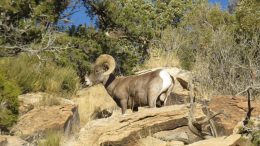A long piece of grass hung loosely from his nose. He looked down at me from his mountain perch, about 500 feet away from where I stood. Staring at his amber eyes, I wondered how many lurking mountain lions this Rocky Mountain bighorn sheep had outwitted in his Colorado National Monument home. He’d also have battled male sheep: Hard-fought clashes to snag prized females have whittled down the edges of his imposing horns, which are etched with deep rings. Like trees, bighorn sheep generally develop one ring on their horns for each year of life.
As I scoured the ancient red cliff faces with binoculars, I noticed that he wasn’t alone. Two young rams, about 20 feet away from him, reclined on a ledge, their spindly legs tucked under lean bellies. One closed his eyes, twitching his erect ears, as if adjusting them to tune into his surroundings.
The sheep appeared at peace, as was I, listening to birds chirp and the wind rustle. No rumbling vehicles pierced the silence in this 20,500-acre monument that sits in the western corner of Colorado.
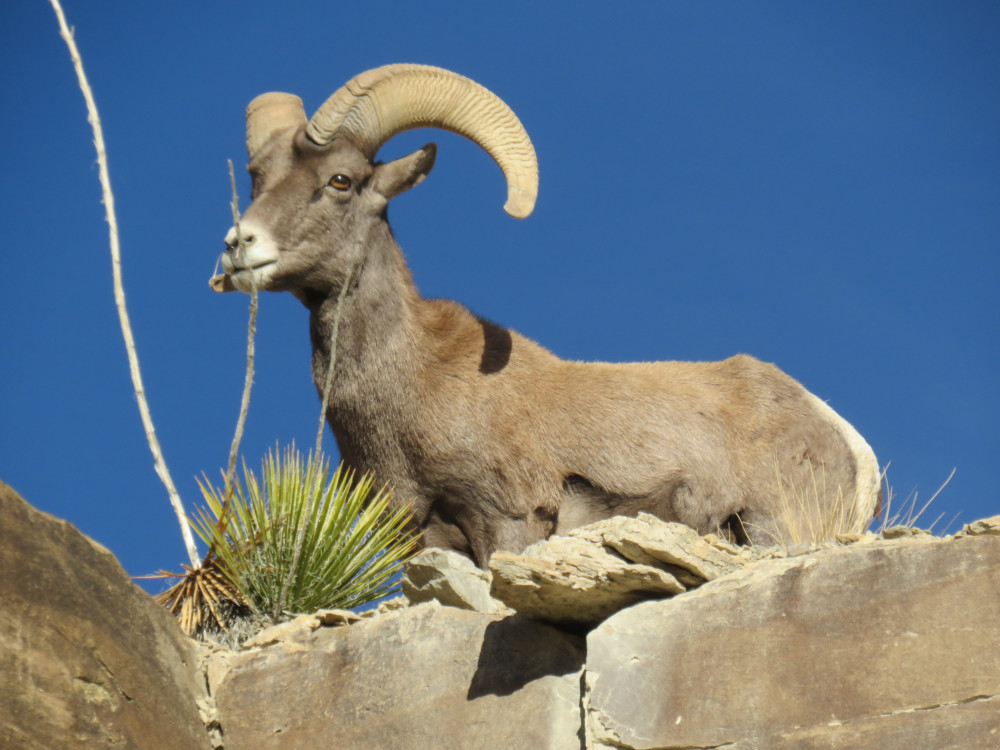
The monument is ideal for bighorn. Rock formations tower into geologic skyscrapers, as if a giant playing Legos has stacked round and square rocks on top of each other. Over billions of years, wind and water — nature’s artists — sculpted the cliffs and mountain ranges into their present-day shapes.
Today bighorn sheep are part of the monument’s identity, but that hasn’t always been the case. Hunting and livestock diseases wiped them out from much of the Southwest by the late 1800s. In the early 1980s biologists imported a handful, hoping to restore the local population, but kept the sheep in captivity. The ungulates spent three years living in an enclosure near the monument’s visitor center.
National Park Service wildlife biologist Bill Sloan, who has studied bighorn for over 40 years, remembers when scientists relocated the herds of sheep from Lake Mead in Nevada to Colorado National Monument.
“The conventional wisdom then was that keeping the sheep in enclosures would give them time to acclimate to their new surroundings, as well as mate and reproduce,” Sloan tells me. “It didn’t work, and scientists eventually released the confined sheep back into the wild.”
The unfettered herds embraced their newfound freedom, heading west, trading Colorado National Monument for the wilderness of Dominguez-Escalante National Conservation Area.
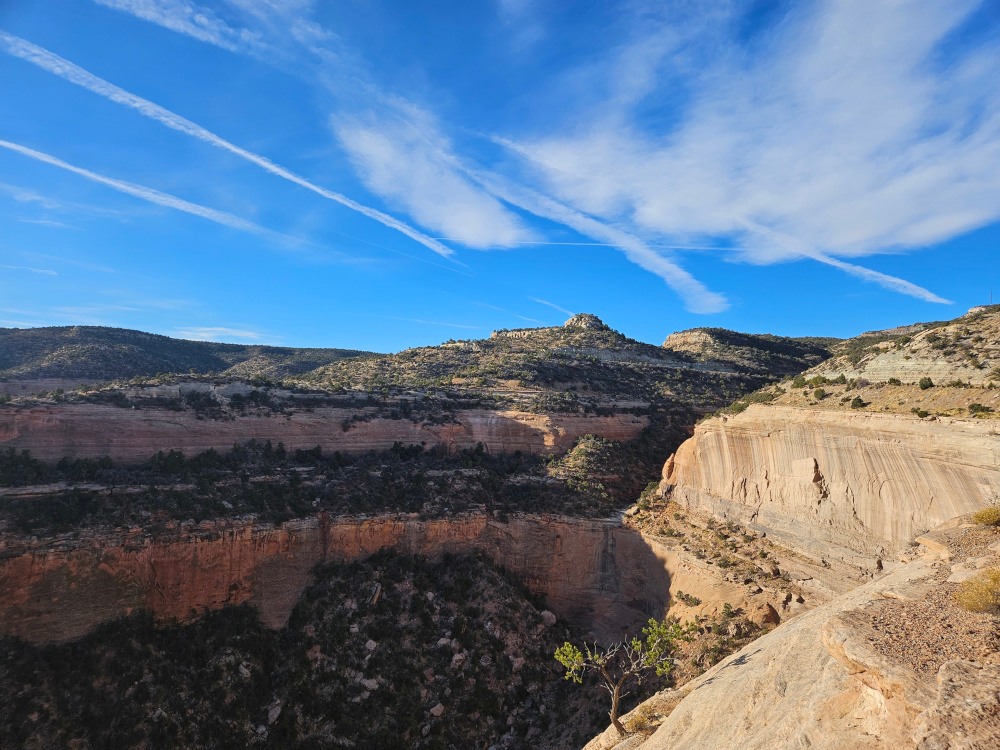
Several years later, around 2010, the relatives of those sheep traveled back to the monument where their ancestors had once lived. Today their numbers have swelled to about 150 — and Sloan worries about them.
“So many sheep are competing for vegetation and water in this small area,” he says. “Their dense numbers make them more vulnerable to predation by mountain lions and disease that can wipe out their populations.”
Among the worst of those diseases is Mycoplasma ovipneumoniae, an often-fatal respiratory disease passed from domestic sheep to wild bighorn, which can extinguish entire herds.
That’s just one of many unceasing threats pummeling bighorn today. Climate change dries up springs and other water sources they rely on. Freeways, strip malls, and other modern entrapments eviscerate their habitat, and with it their ability to find and mate with other sheep. Left isolated on mountain ranges, their limited mating options weaken their gene pool. Protected areas, though important, amount to little more than postage stamps on the landscape — hardly enough for an animal that needs expansive swaths of land to roam.
Most recently, soaring visitation to national parks and other public lands is compromising bighorn survival.
“Sheep are very sensitive to human disturbance,” Sloan points out. “When people encroach on their habitat, they will spend less time foraging. That can lead to ewes not lactating enough and giving birth to weaker lambs, which are less likely to survive.”
Desert Bighorn in Mojave
I share Sloan’s admiration and concern for bighorn sheep.
I first spied these ungulates in 2006 while working as a park ranger in eastern California’s Mojave National Preserve. The desert bighorn in Mojave are the smaller, lighter-brown relatives of their robust Rocky Mountain cousins.
On an early summer Mojave morning, before temperatures rocketed to searing heights, I spotted a desert ewe balanced on a rocky high rise, known as escape terrain, where she could dash away from mountain lions and other predators. She was close, about 50 feet away. Shooting me a furtive glance, she sized me up to determine if I was a threat before deciding that I was harmless.
I froze in place, not wanting to spook her. Eventually she relaxed and went about the business of being a bighorn. I watched her boomerang off cliffs with cloven hooves that grasped rocks like rubber suction cups. Skewering a prickly pear cactus with her pointed horns, she savored the nutritious pulp under the spiky exterior. A nine-stage, complex digestive system enabled her to absorb maximum nutrients from rough desert vegetation.
Time and my worries peeled away that morning. Watching her felt like a gift I could never repay.
The desolate, remote, 1.6 million-acre Mojave is known as the lonely triangle. Cascading dunes, iconic Joshua tree forests, jagged mountain ranges, and expansive dry lake beds support the preserve’s diverse wildlife and plants. But human encroachment infringes on the wildness. Interstate 15 to the north and Interstate 40 to the south hug the preserve. The glittering lights of Las Vegas, about 90 miles from the preserve’s boundary, are visible in otherwise inky skies.
When I started working in Mojave in 2006, it was mostly unknown to the public. Not having the moniker of “national park” made the preserve less sought after. Unlike neighboring Joshua Tree National Park, about a three-hour drive south, Mojave boasted no coffee shops, restaurants, or gas stations. The preserve was more multi-use than a traditional national park, allowing hunting and grazing. But by not drawing throngs of visitors, Mojave retained a wild character that, in some ways, offered it more protection than a national park.
Wild Loss
In 2007 I left the preserve for a national forest, but the wild beauty beckoned me back. I returned in 2010, and at that time Mojave remained relatively unknown. But word soon spread that the backroads of the preserve led to a scenic drive to Las Vegas. It wasn’t long before throngs of travelers started recklessly barreling down those desert roads.
The region paid an instant price. I witnessed desert tortoises crushed under two-ton vehicles. Bighorn sheep, skittering across the road, became casualties. Kit foxes, lizards, bobcats, snakes, mule deer, and a myriad of other wildlife lost their lives to a merciless desert racetrack.
I was not the only one enraged and heartbroken by the wild loss. Sloan has long born witness to how a surge of visitors to national parks endangers bighorn sheep.
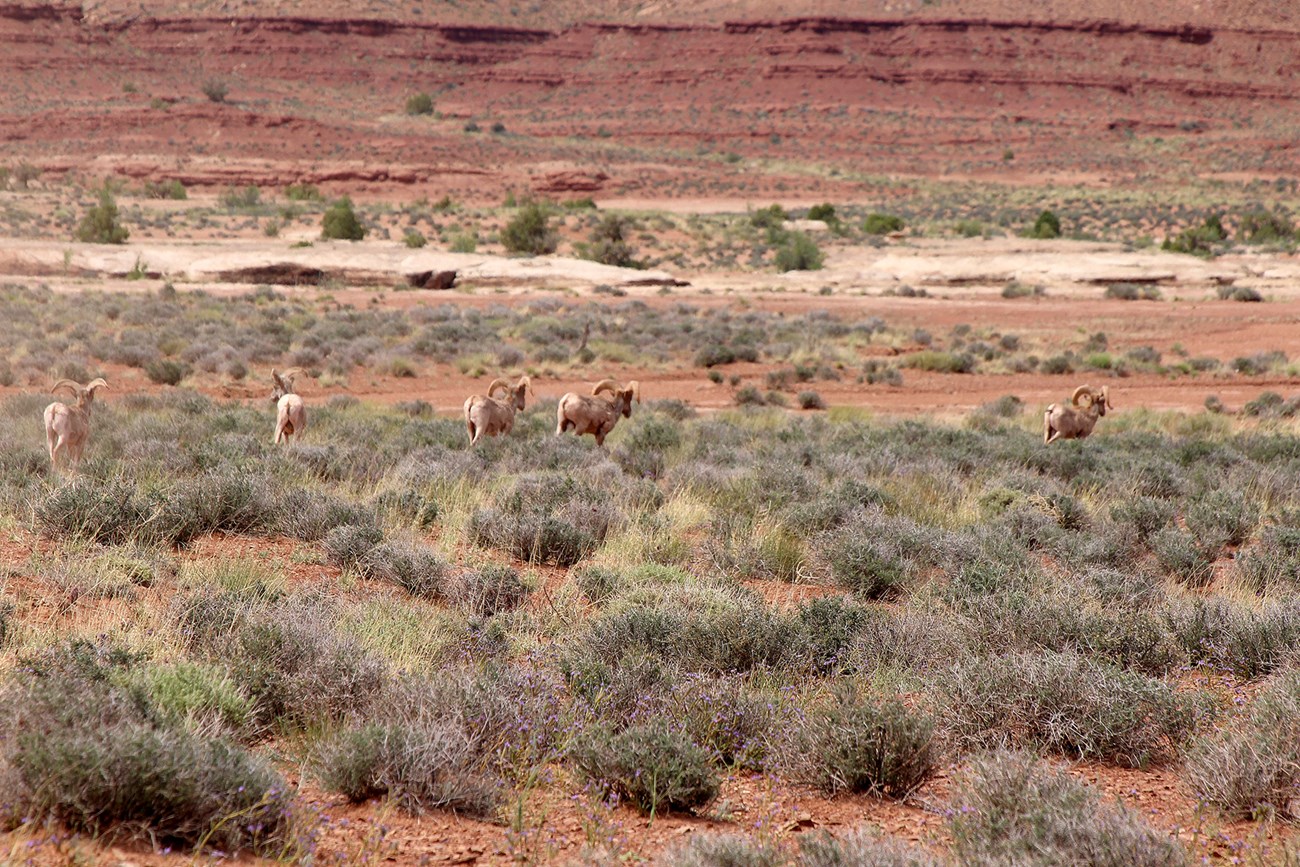
He has observed hordes of people driving and camping along the 100-mile, four-wheel drive White Rim Road in Utah’s Canyonlands National Park.
When the crowds descended 27 years ago, bighorn sheep scattered and abandoned the area. Even today, hundreds of roaring vehicles and raucous parties at campsites scattered along the road keep the bighorn away.
Without people to scare them off, Canyonlands would serve bighorn well. “Cheatgrass sprouts along the edge of White Rim Road, which is very nutritious for bighorn sheep,” Sloan says. “But all the people and noise stresses them out. They fear for their lives.”
‘Your’ Park
The stark differences in the way visitors perceive public lands took center stage when the National Park Service celebrated its centennial in 2016.
That year, wanting to stay relevant with younger audiences, the Park Service launched an ambitious “find your park” campaign. Using social media, the agency encouraged people — many of whom had never visited public lands — to discover their parks. Millions did just that. Many turned to public lands for both reprieve and adventure, following a hallowed tradition of previous generations.
In 1916 the founders of the National Park Service promoted the lands the agency managed as ideal destinations for tourists in search of relaxation and recreation. In the process, the founders made the public a lofty and seemingly contradictory promise: to provide recreational opportunities while leaving resources unimpaired for future generations.
That might have made sense in 1916, when around 326,000 people visited national parks in the United States. By 2016, however, annual visitation to national parks had already risen to more than 330 million. The pressures on park wildlife continued to grow.
A Breather for Wildlife
Four years later, in 2020, the unthinkable happened: A deadly pandemic upended people’s lives.
The Park Service took immediate safety precautions, temporarily shuttering its gates to prevent the spread of Covid. Park visitors were disappointed, but wildlife, including bighorn sheep, relished the respite.
Sloan watched bighorn sheep come back to White Rim Road during Canyonland’s closure, which lasted about seven weeks from March to May 2020. The animals appeared at ease, undisturbed by Sloan’s presence. Many munched on cheatgrass. Some even bedded down close to the road.
“Lamb survival was excellent throughout 2020, despite extreme drought,” Sloan says. “Nearly every ewe I tracked with a GPS collar had a surviving lamb.”
By the end of October 2020, Sloan counted 80 lambs for every 100 ewes — more than double the number of young at any given time during the previous three decades.
“This means it’s possible, if not likely, that the absence of disturbance during the vital spring lambing season allowed pregnant ewes to find more nutritious food,” Sloan says. “Future study would enable us to check this more rigorously.”
Time for a New Campaign
Listening to Sloan, the Park Service mantra echoed in my mind — public lands belong to us.
But that begs the question, what about wildlife that make their homes in public lands? A modicum of etiquette enforces the notion of acting with care and consideration when visiting another’s home.
Perhaps that same respect could extend to wild homes in national parks and other public lands. Modeling the success of the 2016 Park Service centennial, a new campaign could endorse a different mantra: a plea to the public to protect and respect wildlife and their homes. The Park Service could carve out natural preserves that are specially designated for wildlife where the public has no access — areas where animals could be truly free.
“Without human interference, wildlife can thrive,” Sloan emphasizes.
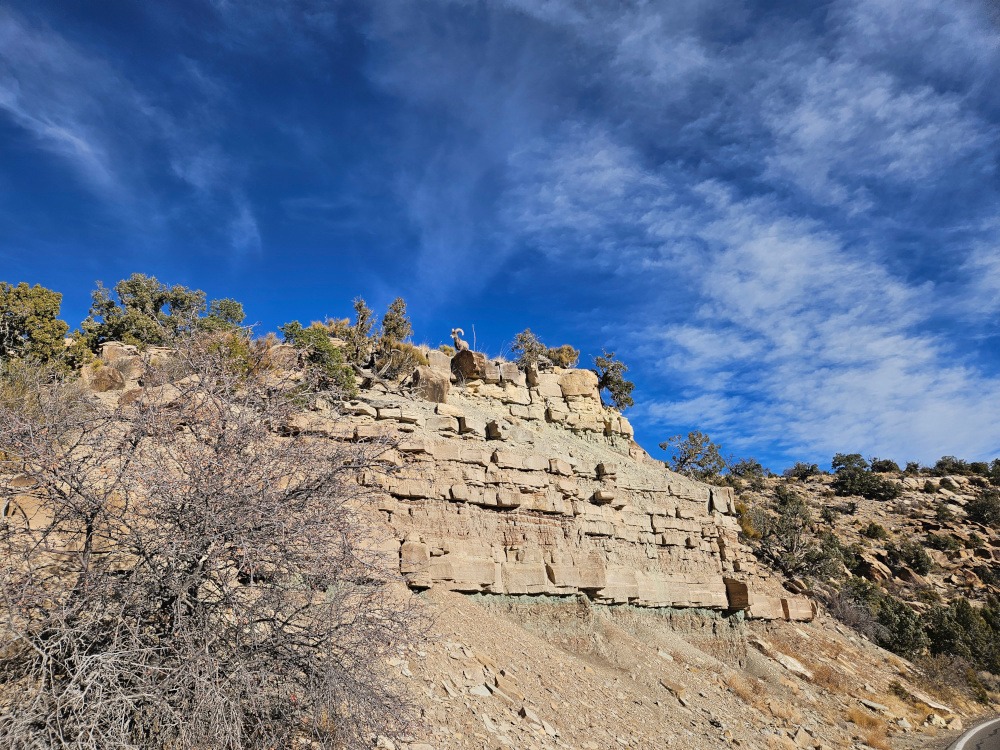
Bighorn and other species need this freedom more than ever. In the wake of the centennial campaign and after the pandemic, National Park attendance continues to soar. In 2023 it reached 325 million people. How can animals persist at that level of constant human presence?
I thought about that while watching the bighorn at Colorado National Monument. A tumbling rock whacked a cliff face, yanking me back to the present. The elder ram rested comfortably on a ledge next to a spiky cucumber-colored yucca, peering over the landscape like royalty.
This is his home, I reminded myself. Walking back to the car, I turned my head and took one last look at him, grateful for time in his presence. He watched me leave, perhaps with a sense of relief.

Previously in The Revelator:
National Parks at Risk From Trump Administration’s Energy Agenda

